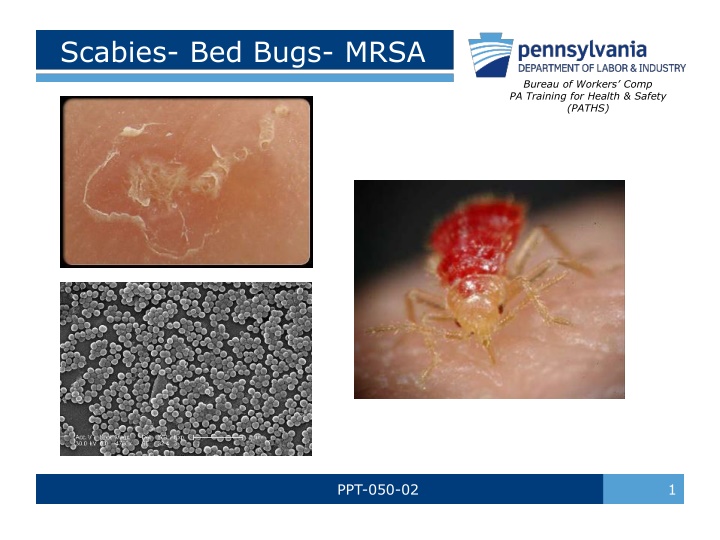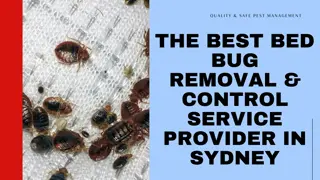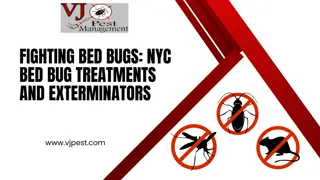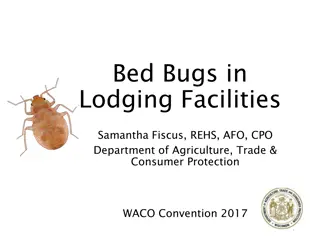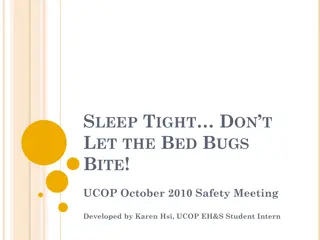Scabies, Bed Bugs, and MRSA
Scabies is caused by an infestation of the itch mite, affecting people of all ages and transmitted through close physical contact. Learn about the signs, symptoms, and prevention methods for scabies, bed bugs, and MRSA in this informative presentation.
Download Presentation

Please find below an Image/Link to download the presentation.
The content on the website is provided AS IS for your information and personal use only. It may not be sold, licensed, or shared on other websites without obtaining consent from the author.If you encounter any issues during the download, it is possible that the publisher has removed the file from their server.
You are allowed to download the files provided on this website for personal or commercial use, subject to the condition that they are used lawfully. All files are the property of their respective owners.
The content on the website is provided AS IS for your information and personal use only. It may not be sold, licensed, or shared on other websites without obtaining consent from the author.
E N D
Presentation Transcript
Scabies- Bed Bugs- MRSA Bureau of Workers Comp PA Training for Health & Safety (PATHS) PPT-050-02 1
What well talk about Scabies What is it? How do you get it? Signs and symptoms; What to do? Bed Bugs What are they? What are their habits? Signs and symptoms of bites; What to do? Protection MRSA What is it? Symptoms, causes and how it is spread; Protection and prevention PPT-050-02 2
Scabies What Is Scabies? Scabies is an infestation by the itch mite, Sarcoptes scabiei Mites are small eight-legged parasites (in contrast to insects, which have six legs) They are tiny, just 1/3 millimeter (.013 inches) long, and burrow into the skin to produce intense itching, which tends to be worse at night The mites that cause scabies are not visible with the naked eye but can be seen with a magnifying glass or microscope PPT-050-02 3
How do you get Scabies? Scabies affects everyone regardless of age, race, gender, social class or personal hygiene habits Transmission of the mites involves close person- to-person contact of the skin-to-skin variety Almost impossible to get from shaking hands or sitting next to someone Sexual contact most common form of transmission Other forms of physical contact can transmit PPT-050-02 4
How long can Scabies last? Mite cannot live more than three days without a human host Can survive up to two months when living on a human Mite also lays eggs in human skin that hatch and grow into adult mites This means that symptoms of the condition can last for months or even years PPT-050-02 5
Signs & Symptoms of Scabies Scabies produce small red bumps and blisters and affect specific areas of the body Scabies may involve: - webs between the fingers, wrists and backs of the elbows, knees, areas around the waist and umbilicus, areas around the nipples, sides and backs of the feet, genital area and the buttocks PPT-050-02 6
What do Scabies look like? Textbook descriptions of scabies always mention "burrows" or "tunnels These are tiny thread-like projections, ranging from 2 mm-15 mm (.08-.6 ) long, which appear as thin gray, brown, or red lines in affected areas The burrows can be very difficult to see PPT-050-02 7
What does Scabies infection feel like? Itching is the most common symptom Itch of scabies is relentless Itch usually worse at night For the first weeks, itch is subtle Gradually becomes more intense until, after a month or two, sleep is almost impossible PPT-050-02 8
Scabies Treatment Besides medication including creams and pills: Wash linens and bedclothes in hot water! Mites don't live long away from the body, therefore not necessary to dry-clean the whole wardrobe, spray furniture/rugs and so forth PPT-050-02 9
What to do Treat sexual contacts or relevant family members (who either have symptoms or have the kind of relationship that makes transmission likely) Cut your nails, and clean under them thoroughly to remove any mites or eggs that may be present Thoroughly vacuum your rugs, furniture, bedding, and car interior and throw the vacuum-cleaner bag away when finished Try to avoid scratching and keep any open sores clean PPT-050-02 10
Bed Bugs PPT-050-02 11
Bed Bugs More of a nuisance than a health hazard, they're showing up to suck blood from people in hotels, college dorms and hospitals PPT-050-02 12
What are they? Bedbugs are small, flat, wingless insects with six legs that, like mosquitoes, feed on blood from animals or people Range in color from almost white to brown, but they turn rusty red after feeding Common bedbug doesn't grow much longer than 0.2 inches (0.5 centimeters) and can be seen by the naked eye to the astute observer They get their name because they like to hide in bedding and mattresses PPT-050-02 13
Bed Bugs The adult is about the size of an apple seed Flat, rusty-brown color until after feeding when they can swell from inch to 3/8 of an inch and turn a deeper red- brown color PPT-050-02 14
Bed Bug Life Cycle PPT-050-02 15
Bed Bugs Easily seen even at the nymph stage Other evidence: Going from each stage, they leave an exoskeleton An almond-like odor may prevail Their droppings may be found Light blood staining may be found after their blood meal PPT-050-02 16
Bed Bugs Attracted by: - Carbon dioxide emitted by humans during sleep - Warmth exuded Do not live on host Feeds then withdraws to its hiding place PPT-050-02 17
Their Habits Nocturnal and can hide in beds, floors, furniture, wood and paper trash during the day Humans usually become their dinner during the night, with peak biting activity just before dawn Can have their meal in as little as three minutes, after which they are engorged and drop off the host, then crawl into a hiding place to digest their meal Bedbugs can live for 12-18 months, and can go weeks without feeding PPT-050-02 18
Bed Bugs on a Mattress PPT-050-02 19
Symptoms & Signs of Bites Don't feel their bite because they inject a numbing agent into your body, along with an anticoagulant to keep your blood flowing as they suck First sign of bedbugs may be itchy, red bites on the skin, usually on the arms or shoulders Bedbugs tend to leave straight rows of bites PPT-050-02 20
What To Do Get rid of infested mattresses and box springs or cover them with a plastic mattress bag to trap the bugs Wash clothes and bedding in hot water, and dry on high heat Clean furniture and vacuum cracks in wood floors and doors where bugs may hide Shake out suitcases and boxes Use an insecticide in the cracks of floors or bed frames, but read the label; do not apply to areas that come in direct contact with skin PPT-050-02 21
Suggestions Vacuuming can remove some bed bugs, but their eggs are sticky and adhere to surfaces, making them difficult to pick up If you vacuum, do so carefully so the vacuum cleaner doesn t spread the bed bugs Empty vacuum bags and canisters into plastic bags that seal tightly, preventing the bugs from escaping Check vacuum s brushes and attachments for bed bugs immediately after vacuuming PPT-050-02 22
Protection Don t sit on beds, couches, chairs, etc. in rooms where bed bugs are suspected Shoe covers can be worn and should be removed and discarded before leaving room If you bring items in, seal them in a garbage bag or plastic bin when not in use When you return home, wash your clothes in hot water (120oF) for at least 20 minutes or put them directly into a dryer on the hot setting for at least 20 minutes PPT-050-02 23
Protection Steam cleaning, washing and other heat applications can be used for removal Isopropyl alcohol kills the bugs but not the eggs Bleach may ruin fabrics and furniture and irritate the skin although it can be used on items which can be laundered and hard surfaces, i.e. mattress frames Boric acid is not effective and may be toxic to children and pets There are available materials to encapsulate mattresses, sprays and insecticides PPT-050-02 24
Prevention Trends Thoroughly clean suspect areas Seal mattress with hypoallergenic, zippered mattress cover labeled allergen rated or for dust mites Seal cracks, crevices, potential entry points or areas where bed bugs may hide Get rid of heavily infested items which can not be cleaned by sealing in plastic bag and discard outside This process of cleaning and separation may need to be repeated to completely eliminate an infestation If you can not remedy the situation, contact a professional exterminator with a good reputation PPT-050-02 25
MRSA PPT-050-02 26
MRSA Methicillin-resistant Staphylococcus aureus (MRSA) is a bacterium that causes infections in different parts of the body It's tougher to treat than most strains of staphylococcus aureus - or staph - because it's resistant to some commonly used antibiotics PPT-050-02 27
MRSA Symptoms The symptoms of MRSA depend on where you're infected Most staph skin infections, including MRSA, appear as a bump or infected area on the skin that may be: - Red - Swollen - Painful - Warm to the touch - Full of pus or other drainage - Accompanied by a fever PPT-050-02 28
What it looks like PPT-050-02 29
Causes Garden-variety staph are common bacteria that can live on our bodies Plenty of healthy people carry staph without being infected by it; 25 percent to 30 percent of us have staph bacteria in our noses Can be a problem if it manages to get into the body, often through a cut; once there, it can cause an infection Staph is one of the most common causes of skin infections in the U.S. Usually, these are minor and don't need special treatment, however it can cause serious problems like infected wounds or pneumonia PPT-050-02 30
How is MRSA spread Having direct contact with another person s infection Sharing personal items, such as towels, bar soap, razors that have touched infected skin Touching surfaces or items, such as used bandages, contaminated with MRSA PPT-050-02 31
MRSA and Surfaces Even if surfaces have staph/MRSA on them, does not mean a person will definitely get an infection if they touch these surfaces. Staph and MRSA are most likely to cause problems when someone has a cut or scrape that is not covered (always cover cuts and open wounds). MRSA can also get into small openings in the skin such as openings at hair follicles. Length of survival on surfaces depends on temperature, humidity, amount of staph/MRSA present, and type of surface. Also depends on if surfaces have nutrients allowing it to survive longer. PPT-050-02 32
Protection Methods Know the signs of MRSA skin infections and get treated early Keep cuts and scrapes clean and covered Use good hygiene such as washing hands regularly (for at least 20 seconds) Use alcohol-based hand sanitizer Do not share personal items such as towels and razors Wear rubber gloves while cleaning PPT-050-02 33
Prevention Methods Wash towels, bedding and clothing in hot water and bleach and dry in a hot air dryer to help kill the bacteria Wipe down shared desks, keyboards, phones, light switches, and equipment regularly Clean surfaces and equipment that may have been contaminated with a commercial disinfectant or with a 1:10 bleach and water solution PPT-050-02 34
Bottom Line Scabies, Bed Bugs, MRSA Use common sense - don t share personal items! Use good personal hygiene such as washing your hands frequently (20 seconds at least) Wash work clothes in very hot water and dry at hot setting Wear gloves when cleaning Wipe down shared areas regularly For bed bugs: check mattresses frequently, don t take boxes/bags into affected areas PPT-050-02 35
Resources WebMD Medicinenet.com CDC (Centers for Disease Control & Prevention) PA Department of Health Mayoclinic Badbedbugs.com PPT-050-02 36
Contact Information Health & Safety Training Specialists 1171 South Cameron Street, Room 324 Harrisburg, PA 17104-2501 (717) 772-1635 RA-LI-BWC-PATHS@pa.gov PPT-050-02 37
Questions PPT-050-02 38
IUP OSHA Consultation Program Telephone Number 1-800-382-1241 PPT-000-00 00
Bibliography For Scabies info: http://en.wikipedia.org/wiki/Scabies http://www.cdc.gov/parasites/scabies/gen_info/faqs.html For Bed Bug Info: http://bedbugsremovalguide.com/ http://www.bedbugsremovalguide.com/kill-bed-bugs.html For MRSA info: http://www.ncbi.nlm.nih.gov/pubmedhealth/PMH0004520 PPT-050-02 39
